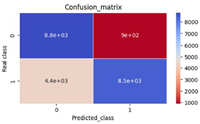Parameter estimation for photovoltaic systems: An enhanced Broyden-like approach
Abstract
Solar energy, specifically photovoltaic systems, has emerged as a prevalent source of electrical power worldwide, gaining acceptance on many continents. While numerous African countries are gradually embracing this alternative energy due to abundant sunlight, the high cost of solar panels and accessories remains a barrier to widespread adoption. This study focuses on refining recently developed iterative methods, leveraging quadrature rules of integration, to accurately estimate parameters in the design of photovoltaic (PV) systems for predetermined power outputs under diverse environmental conditions. The research compares these methods, particularly the authors’ MS-3/8 and TS-3/8 approaches, with the commonly used Newton-Raphson method. In the examination, a 10 W PV system with a single diode PV module is considered. Results indicate that the MS-3/8 method demonstrates greater efficiency and requires fewer iterations to converge to the estimated power output of the PV system compared to the Newton-Raphson method and other approaches by different authors. Ultimately, the research introduces a suggested mathematical model for a Four-Diode PV system, offering an alternative method for determining the parameters of the photovoltaic system.
References
[1]Isaac A, Boakye Stephen T, Seidu B. A New Trapezoidal-Simpson 3/8 Method for Solving Systems of Nonlinear Equations. American Journal of Mathematical and Computer Modelling. 2021; 6(1): 1. doi: 10.11648/j.ajmcm.20210601.11
[2]Hashim E, Talib Z. Study of the performance of five parameter model for monocrystalline silicon photovoltaic module using a reference data. FME Transactions. 2018; 46(4): 585-594. doi: 10.5937/fmet1804585t
[3]Isaac A, Boakye Stephen T, Seidu B. A Comparison of Newly Developed Broyden-Like Methods for Solving System of Nonlinear Equations. International Journal of Systems Science and Applied Mathematics. 2021; 6(3): 77. doi: 10.11648/j.ijssam.20210603.11
[4]Murakami T, Anbumozhi V. Global Situation of Small Modular Reactor Development and Deployment. ERIA; 2021.
[5]Azure I. An Analysis of Solutions of Nonlinear Equations Using AI Inspired Mathematical Packages. International Journal of Systems Science and Applied Mathematics. Published online September 8, 2023. doi: 10.11648/j.ijssam.20230802.12
[6]Reis LRD, Camacho RJ, Novacki DF. The Newton Raphson method in the extraction of parameters of the PV modules. In: Proceedings of the International Conference on Renewable Energies and Power Quality (ICREPQ’ 17); Malaga, Spain. pp. 4-6.
[7]Kheirkhah AR, Meschini Almeida CF, Kagan N, et al. Optimal Probabilistic Allocation of Photovoltaic Distributed Generation: Proposing a Scenario-Based Stochastic Programming Model. Energies. 2023; 16(21): 7261. doi: 10.3390/en16217261
[8]Kheirkhah AR, Pozos AT, Zandrazavi SF, et al. A Stochastic Programming Model for the Optimal Allocation of Photovoltaic Distributed Generation in Electrical Distribution Systems Considering Load Variations and Generation Uncertainty. Simpósio Brasileiro de Sistemas Elétricos-SBSE. 2020; 1(1). doi: 10.48011/sbse.v1i1.2247
[9]Pennsylvania State University. 2.6 The Hawthorne Effect. Advanced Energy Systems (AE 868). Available online: https://www.e-education.psu.edu/ae868/node/518 (accessed on 3 February 2021).
[10]Prabu RT, Parasuraman S, Sahoo S, et al. The Numerical Algorithms and Optimization Approach Used in Extracting the Parameters of the Single-Diode and Double-Diode Photovoltaic (PV) Models. International Journal of Photoenergy. 2022; 2022: 1-9. doi: 10.1155/2022/5473266
[11]Benabdelkrim B, Benatillah A. Modeling and Parameter Extraction of PV Cell Using Single- and Two-Diode Model. International Journal of Energetica. 2017; 2(2): 06. doi: 10.47238/ijeca.v2i2.40
[12]Kisabo AB, Uchenna NC, Adebimpe FA. Newton’s method for solving non-linear system of algebraic equations (NLSAEs) with MATLAB/Simulink and MAPLE. American Journal of Mathematical and Computer Modelling. 2017; 2(4): 117-131.
[13]Belarbi M, Boudghene-Stambouli A, Belarbi EH, et al. A new algorithm of parameter estimation of a photovoltaic solar panel. Turkish Journal of Electrical Engineering & Computer Sciences. 2016; 24: 276-284. doi: 10.3906/elk-1308-60
[14]Bikaneria J, Joshi SP, Joshi AR. Modeling and Simulation of PV Cell using One-diode model. International Journal of Scientific and Research Publications. 2013; 3(10): 1-4.
[15]Sharadga H, Hajimirza S, Cari EPT. A Fast and Accurate Single-Diode Model for Photovoltaic Design. IEEE Journal of Emerging and Selected Topics in Power Electronics. 2021; 9(3): 3030-3043. doi: 10.1109/jestpe.2020.3016635
[16]Dharmarajan R, Ramachandran R. PV Module Parameter Estimation Using Newton Raphson. International Research Journal of Multidisciplinary Technovation. 2019; 1(4), 28-40.
[17]Ahmad T, Sobhan S, Nayan MdF. Comparative Analysis between Single Diode and Double Diode Model of PV Cell: Concentrate Different Parameters Effect on Its Efficiency. Journal of Power and Energy Engineering. 2016; 04(03): 31-46. doi: 10.4236/jpee.2016.43004
[18]Bonkoungou D, Koalaga Z, Njomo D. Modelling and Simulation of photovoltaic module considering. International Journal of Emerging Technology and Advanced Engineering. 2013; 3(3): 493-502.
[19]Rusirawan D, Farkas I. Identification of Model Parameters of the Photovoltaic Solar Cells. Energy Procedia. 2014; 57: 39-46. doi: 10.1016/j.egypro.2014.10.006
[20]Pukhrem S. A Photovoltaic Panel Model in Matlab/Simulink. ResearchGate. 2013; 20-23.
[21]Tamrakar V, Gupta SC, Sawle Y. Study of characteristics of single and double diode electrical equivalent circuit models of solar PV module. In: Proceedings of the 2015 International Conference on Energy Systems and Applications. doi: 10.1109/icesa.2015.7503362
Copyright (c) 2024 Isaac Azure, Stephen B. Twum, Baba Seidu

This work is licensed under a Creative Commons Attribution 4.0 International License.











